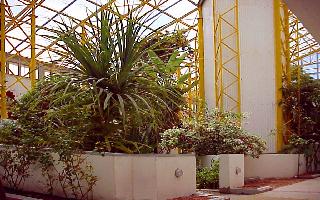Back to Man > Building in the Desert
Although the bioclimatic design of buildings goes far to maintain stable living conditions, additional devices may be required in some building types to complement the passive energy exchanges carried out by the structure itself. BIDR researchers are developing novel low-energy, environmentally friendly devices to supply these needs (Erell E. and Etzion Y. 2000).
Click here for Building Themal Simulation
Evaporative coolers are commonplace devices for the conditioning of building spaces in arid regions where the air is sufficiently dry. Researchers in the architecture group (Pearlmutter, Etzion, Erell and Meir, 1996) have developed a sophisticated variety of cooler that is applicable to large exterior and semi-enclosed spaces. The advanced evaporative cooler was designed, developed and integrated into the design of a 500 sq. m. (5000 sq. ft.) courtyard, or atrium, located at the heart of the BIDR's Blaustein International Center for Desert Studies building.

At the right: Ten-meter-high evaporative cooling tower in the courtyard of the Blaustein International Center for Desert Studies.
Animation of the operation of the BIDR evaporative cooling tower. Air entering at 36.0°C and exposed to a continuous fine spray of water exits the bottom of the tower at a comfortable 21.5°C, thereby cooling the enclosed atrium and surrounding buildings.
Nozzles at the upper level of the 10-meter-high, tower-like device release fine drops of water, which as they evaporate - cool the air inside, which then moves downward towards the opening at the bottom of the tower. This "down-draft" effect results from the relatively heavy cool air sinking through the tower and drawing warmer outside air in its wake, to be cooled in turn by the spray. The flow is bolstered by both a wind-scoop on top of the tower and an electric fan.
Analysis of system performance showed a temperature reduction of up to 14oC when compared to outside temperatures. Cooling efficiency amounted to 85-90% during all hours of operation, providing over 1,000 kWh of cooling on a hot summer day through the evaporation of 1-2 cu. m. of water.
Previous section Next section